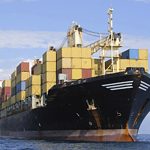CNBC reports that the number of Chinese freight vessels headed to the Ports of Los Angeles and Long Beach, the top destinations for Asian freight, has dropped sharply. The latest information obtained by SGB Media shows that the ports have continued to shrink since the first report.
CNBC, the business news network, soon to be spun off from NBC Universal, said in a post that the trade war between China and the U.S. is leading to a demand plummet, and ocean carriers have started to suspend or adjust transpacific services.
“We are at a tipping point on the West Coast,” one logistics expert was reported to have told the media outlet. Still, the weekly year-over-year declines may not be attributed to declining demand but to shipments pulled forward due to a shift in U.S. holidays and moves made by Asian factories and U.S. brands to ship goods early to get products in before the tariffs hit. Others may be playing chicken with the Trump Administration, betting who will blink first and stand down on the tariff demands. However, the Dow and the S&P 500 bounced on April 22 after U.S. Treasury Secretary Scott Bessent, Trump’s primary negotiator on tariff deals, said that he believes the Trump Administration’s ongoing tariff war with China will de-escalate soon because the ongoing rift is not sustainable, according to a rough transcript read-out and obtained by Bloomberg.
“The next steps with China are, no one thinks the current status quo is sustainable at 145 [percent] and 125 [percent],” Bessent said at JPMorgan’s closed-door investor summit in Washington, DC. “So I would posit that over the very near future, there will be a de-escalation.”
Some analysts were concerned that the U.S. has not started any conversations with anyone in China, so Bessent’s comments could be premature.
For the week ending May 3, the number of freight vessels leaving China and headed to the Southern California ports, the main U.S. ports receiving Chinese freight and other Asian trade, is down 29 percent week-over-week, according to Port Optimizer, a ship tracking system.
Year-over-year, the data shows a 44 percent drop in vessels scheduled to arrive the week of May 4 through May 10. The shipping data is updated daily based on the vessel manifests declaring the port destination. These vessels are either scheduled to leave Asia or are on the water and headed to these ports.
Port Optimizer reported that twelve vessels will arrive this week, down from 22 the week of April 20. Measured in shipping containers, 62,568 TEUs (twenty-foot equivalent units) will arrive the week of May 4 through May 10, versus 120,608 TEUs as recently as the week of April 20 through April 26.
“We are at a tipping point on the West Coast,” said Chief of Analytics Ken Adamo at DAT Freight & Analytics. “Looking at how many truck loads are available versus trucks, we’ve seen a precipitous drop; over 700,000 loads have evaporated nationally in the past week compared to two weeks prior.”
Image courtesy Port of Los Angles/Infographic courtesy Port Optimizer

















